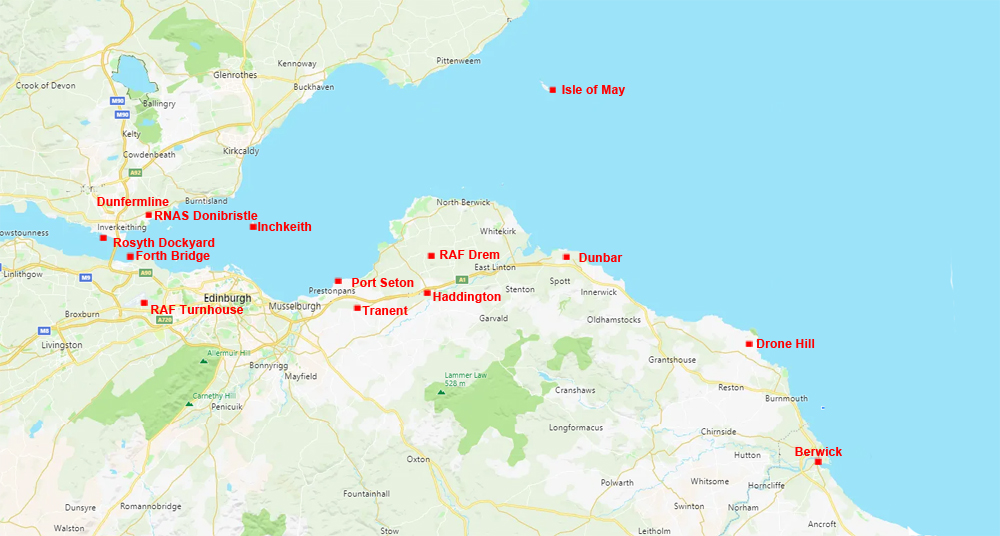First Air Raid of WWII – 12
14:00 – the first wave of bombers makes landfall
| < 11 Bombers en-route | Δ Index | 13 second wave arrives > |

Just before 14.00 hours, with the rest of the group having drifted apart and scattered over a widespread area, the co-pilot in Pohle’s Ju88 spotted the British coastline approximately 20 miles ahead. They had marked Berwick-on-Tweed as the place on the map where they should make landfall (they were using a British Ordnance Survey map of southern Scotland purchased in London the year before).
From Berwick (not to be confused with North Berwick) their route to Rosyth was marked out. Pohle recalled: ‘I came straight as an arrow from Westerland to the south coast of the Firth of Forth, just over the anchor place of the cruisers.’ Against his original plan, he led his section in to attack from the east, into the sun, and not out of it.
Due to the intense air activity that morning a certain amount of confusion reigned at the Turnhouse control room.
The aircraft of KG30 flew into an area which had already experienced a number of sightings of unidentified aircraft, most false. Whilst there were several reports of enemy aircraft having been sighted in the airspace over Dunbar (one of which was from a searchlight crew who reported six Heinkels at 13.25 which turned out to be the Sea Skuas from RNAS Donibristle), it is likely that some of these were accurate as, according to Pohle, he brought his section over mainland Scotland in the Dunbar area, north of his intended landmark of Berwick-on-Tweed.
His course took his section more or less straight towards the Forth Rail Bridge, south of Drem near Haddington and over the south shore of the Forth over Port Seton. With the other two Ju88s flying at a distance of a quarter of a mile each side of his own, he now had a visual of the instantly recognisable 340 foot high spans of the Forth Rail Bridge and continued on his heading straight for it. As he did so he began his descent from 23,000 feet to 12,000 feet, from which he planned to carry out his attack.

Being in such close proximity to the fighter airfield of Drem the crew would have been on the look-out for RAF fighters and tension at the prospect of interception would have been heightened. As they progressed their Junkers gradually became more recognisable to those on the ground.
Fourteen-year-old David Watson was on his way back from Dunbar to Edinburgh with his parents when, at the summit of Pencraik Brae – part of the A1 between East Linton and Haddington – he spotted aircraft which appeared to be flying west. He recalled: ‘The sun roof of my father’s Austin Ten was open and I recall standing up to get a better view. I could see the crosses on the aircraft. ‘ It was after returning to Edinburgh that the teenager learned of the air-raid. It is most likely that the aircraft spotted by David Watson was the section led by Helmut Pohle.
Eyewitnesses in Tranent saw the aircraft a few minutes later over Port Seton where Pohle crossed the south shore of the Firth of Forth. Now flying up the Forth, Pohle next passed Inchkeith Island situated below on his right in the middle of the river (whilst Inchkeith was manned by a detachment of the 7/9 Royal Scots Regiment it had no anti-aircraft armament at that time).
| < 11 Bombers en-route | Δ Index | 13 second wave arrives > |